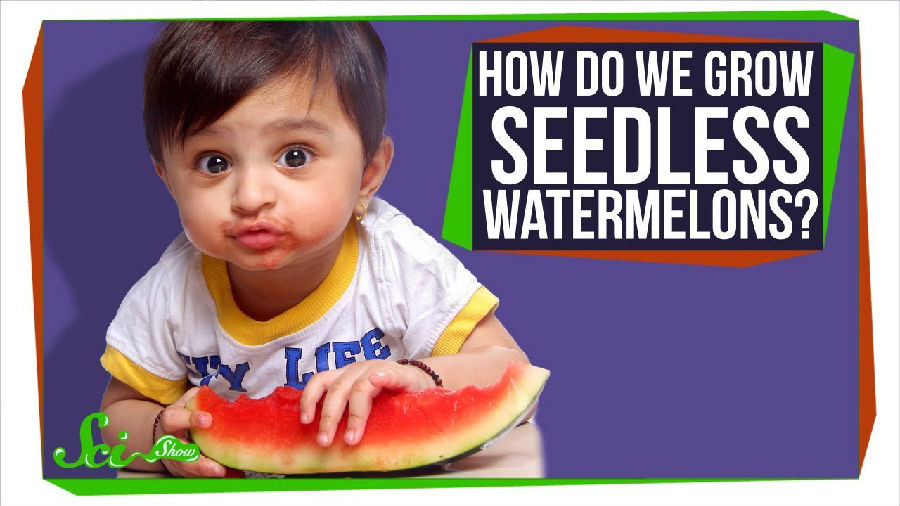(单词翻译:单击)
The only thing better than a nice, juicy bite of ripe watermelon is the same bite without all those annoying seeds.
比咬一口美味多汁的西瓜更棒的事只有啃一口没有籽的西瓜。
Which is why seedless watermelons are basically the best thing ever.
所以根本而言无籽西瓜就是最棒的事。
But they're also a delicious paradox. Like, seeds are kind of a key part of plant reproduction.
但是它们也是一种甜美的悖论。比如,种子是植物繁殖的一个关键部分。
So how do you breed a plant that doesn't make any seeds?
所以要怎么培育没籽的植物呢?
Well, it takes some genome-altering chemicals and simultaneously growing three genetically-distinct watermelon plants.
这需要一些改变基因的化学物质,同时也需要种植三颗基因不同的西瓜。
And similar methods can produce all sorts of seedless fruits.
类似的方法可以培育出所有种类的无籽水果。
Five thousand years ago, watermelon's wild ancestor was a small, hard, bitter African fruit.
五千年前,西瓜的野生原种是一种小而坚硬苦涩的非洲水果。
Centuries of selective breeding for desirable traits led to sweeter, juicier, red melons with shiny black seeds.
几世纪的选择性繁殖培育出了一种更甜美多汁且带有黑籽的红色瓜果。
Then, about 80 years ago, Japanese scientists tinkered with the plants' genome more directly to create seedless varieties.
然后约80年前,日本科学家更加直接地修补了西瓜的基因组创造出了无籽品种。
They used a process known as mutation breeding:
他们利用一种名为诱变育种的方法:
basically, plants are exposed to something that induces changes to their genomes,
就是将植物暴露在一些诱导它们改变基因的物质中,
and then scientists look for ones that have some desirable trait.
然后科学家们在其中寻找某些理想的特质。
The scientists that made seedless watermelons in 1939 used a chemical called colchicine.
1939年培育出无籽西瓜的科学家们利用了一种被称为秋水仙碱的化学物质。
It messes with the proteins that make up microtubules, filamentous structural proteins in cells that help shuttle things around.
将其与组成微管的蛋白质(帮助运输的细胞中的丝状结构蛋白)混合。
In people, that makes it a treatment for gout because it tones down inflammation.
对于人类,这是一种治疗痛风的方法,因为它能缓和炎症。
But in plants, it makes cells fail to separate duplicated DNA properly when dividing, resulting in what are called ploidy changes:
但对于植物,它会让细胞无法正确分隔复制DNA,结果导致了倍性变化:
alterations to the number of complete sets of chromosomes in each cell.
每个细胞中成套染色体数量的更改。
Animals with more DNA than they should have usually don't survive
拥有超量DNA的动物通常无法存活

but plants seem to be totally chill with multiple copies of their genomes.
但是拥有多个副本基因组的植物似乎完全不受影响。
Like humans, watermelons evolved to be diploid— they have two complete sets of chromosomes in their cells.
和人类一样,西瓜进化出倍数染色体—它们的细胞中有两套染色体。
But in 1939, a professor at Kyoto University used colchicine to double the number of chromosomes in one of his watermelon lines,
但在1939年,京都大学的一名教授利用秋水仙碱加倍其中一条西瓜线的染色体数量,
creating a tetraploid watermelon. Then, when he bred the two plants together, the offspring were triploid.
从而创造出了一种四套染色体西瓜。然后,当他将两种植物共同培育时,它们培育出的产物有三套染色体。
Triploid watermelon plants can't make viable seeds because the cellular process that makes reproductive cells in plants requires matching chromosome sets.
三套染色体西瓜不能产出有活性的种子,因为制造繁育细胞的细胞进程需要匹配染色体组。
But planting these genetic weirdos isn't the last step to delicious, seedless fruit.
但是种植这些基因怪种并不是生产美味无籽西瓜的最后一步,
So to get seedless watermelons, you have to pollinate female flowers on a triploid plant with the pollen from male flowers from a diploid plant.
所以为了得到无籽西瓜,你需要使用二倍体植物的雄性花蕊给三套染色体植物的雌性花蕊授粉。
And since the triploid plants don't produce seeds, you have to keep mating diploid and tetraploid plants to make them—
由于三倍染色体植物不能产籽,所以你需要不断地让倍数染色体和四套染色体植物交配
so you end up having to grow at least three watermelon plants to get seedless crop every year.
所以你需要培育至少三种西瓜才能每年生产出无籽作物。
If that sounds like a lot of work, well, it is, but people are so fond of the seedless varieties that it's worth it to farmers.
如果这听起来工作量繁重,确实如此,但是人们超喜欢无籽品种,对农民而言是值得的。
And researchers have tried to make the process a little smoother.
研究人员已经尝试着简化培育过程。
They've developed a diploid line which doesn't make female flowers,
他们开发了一种不需要雌性花蕊的二倍体品系,
so farmers can plant it for its pollen without accidentally making any seeded watermelons, for example.
所以农民可以利用其花粉种植西瓜且不会意外种植出有籽西瓜。
Watermelon isn't the only seedless fruit that we enjoy because of ploidy changes—
西瓜并不是唯一一种因倍性变化而被人类所享受的无籽水果—
seedless grapes, citrus fruits, and bananas were all created with ploidy manipulation.
无籽葡萄、柑橘类水果以及香蕉都是倍数性操作而生产出的。
But counterintuitive as it might sound, none of them are considered GMOs—
但是这听起来或许有些违反常理,它们都不是基因改造生物—
even though they're very much genetically modified—
虽然它们的基因经过修改—
because only crops created with modern transgenic technologies fall under that label for some reason.
由于某些原因,只有经过现代转基因技术创造出来的作物才能被贴上基因改造生物的标签。
Something to chew on the next time you're enjoying a sweet slice from the offspring of a chemically-treated melon mom.
下一次你在享受化学改造瓜果的后代时,可以考虑一下这个。
Thanks for watching this episode of SciShow! And a special thanks to our patrons on Patreon.
感谢收看本期《科学秀》!特别感谢Patreon上的赞助人。
Kind of like farming seedless watermelons, it takes a lot of work to make SciShow videos,
和种植无籽西瓜类似,需要大量工作才能制作出《科学秀》视频,
and we wouldn't be able to cultivate all of the talented people that work on them if it weren't for our patrons.
如果没有我们的赞助人,那么我们无法培育出所有为此努力的人才。
If you want to learn more about our Patreon community
如果你想了解更多关于Patreon社区的信息
and how you can keep us doing what we do best, you can go on over to Patreon.com/SciShow
以及如何支持我们,可以登陆Patreon.com/SciShow。


